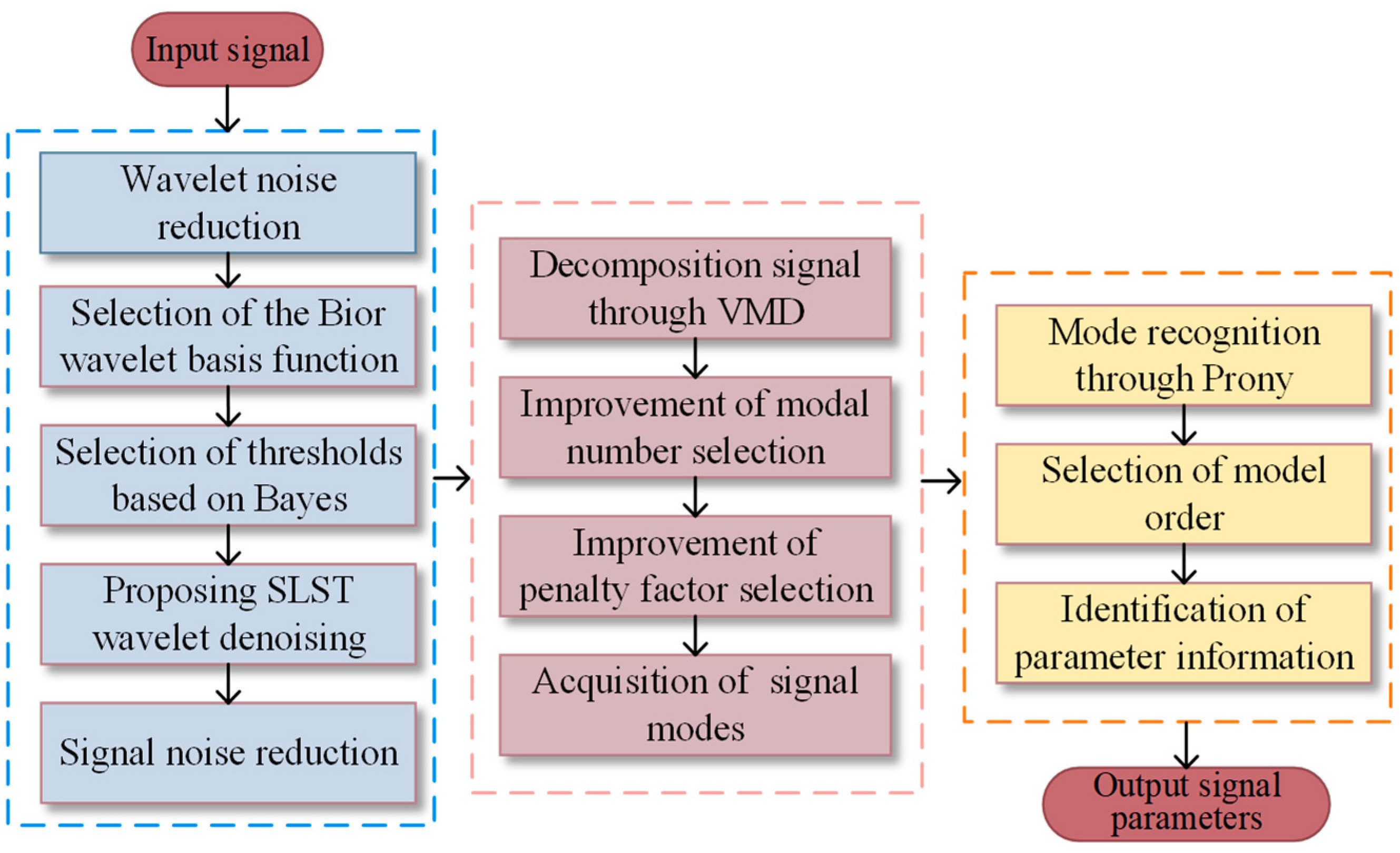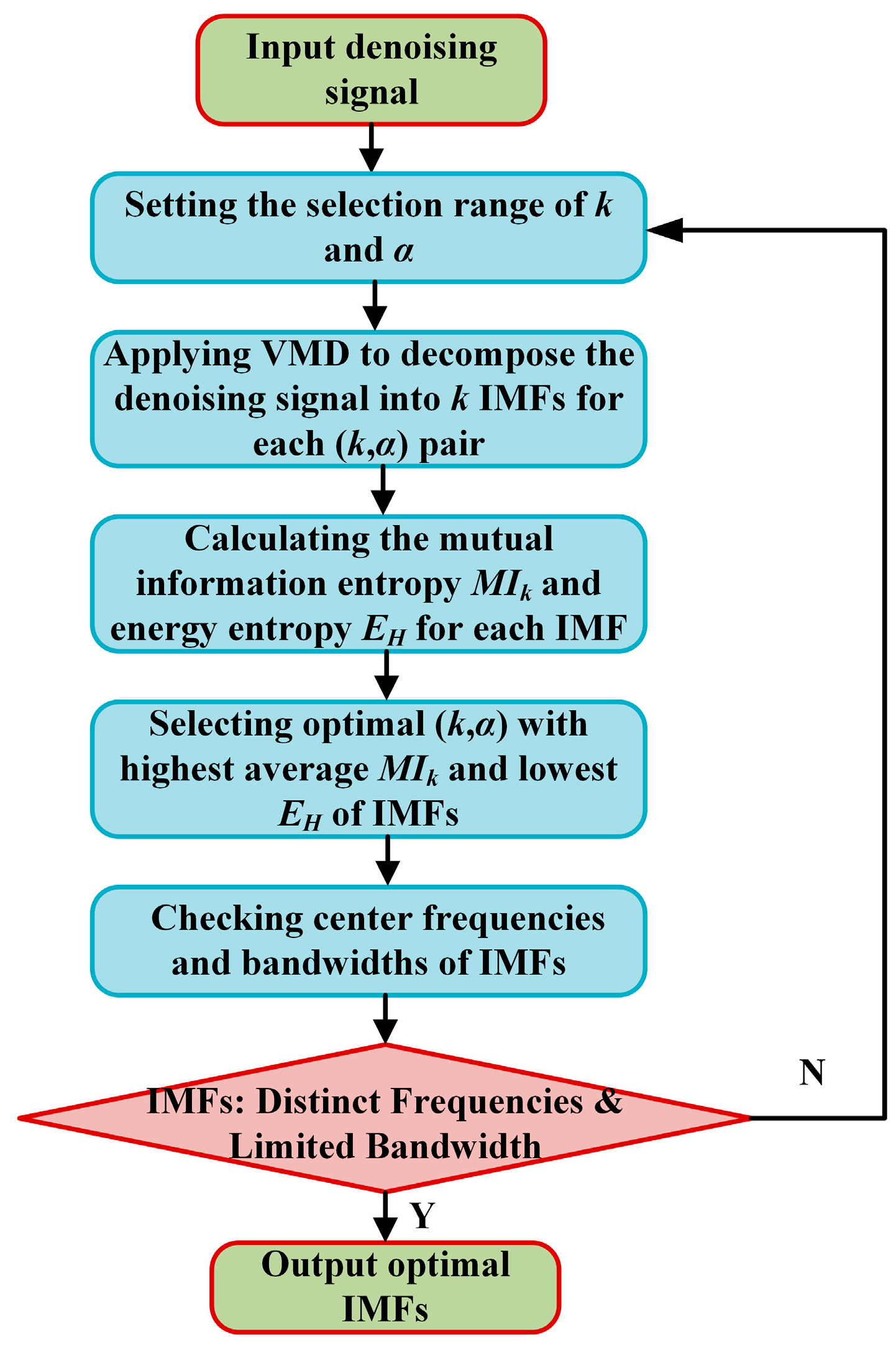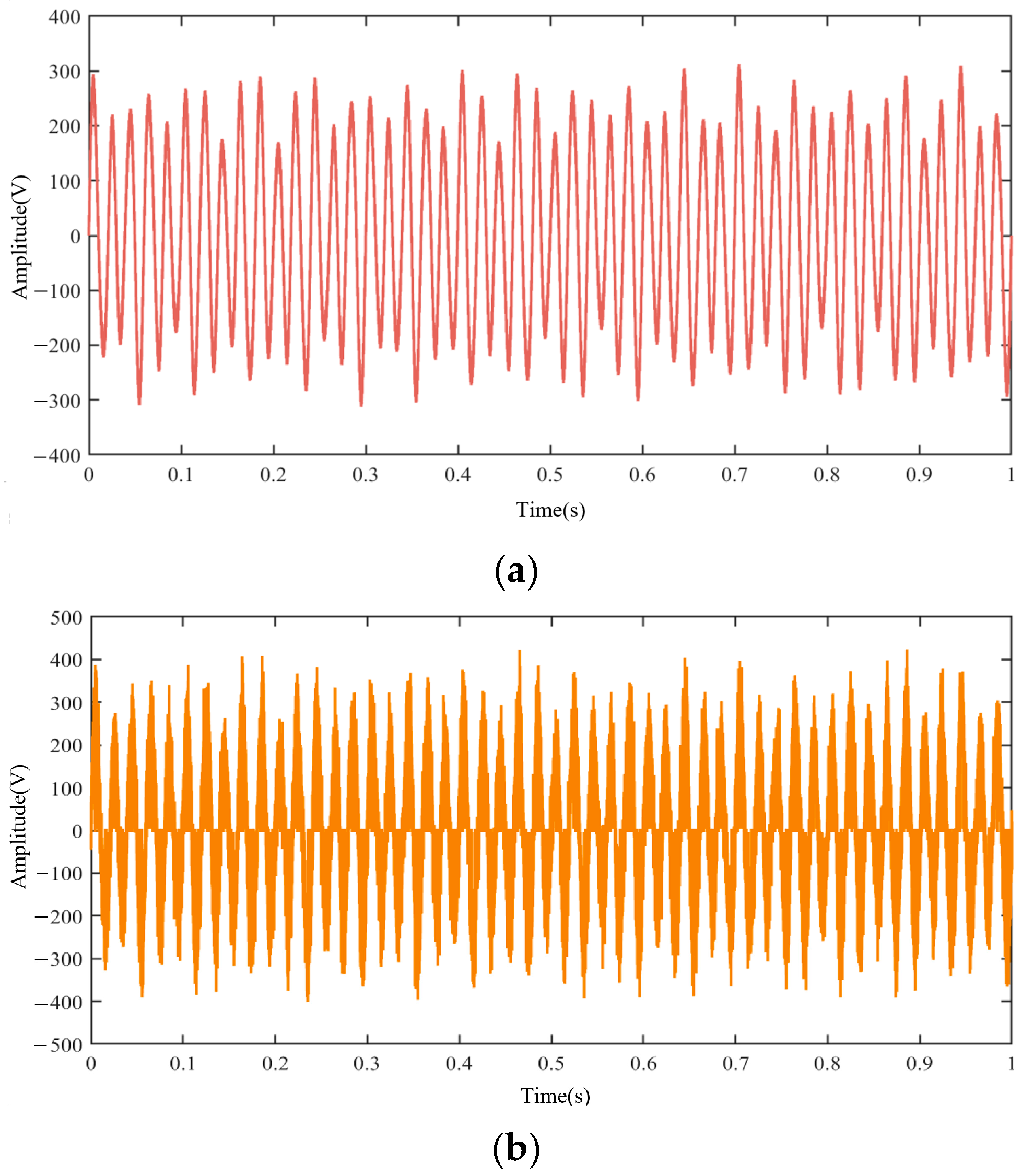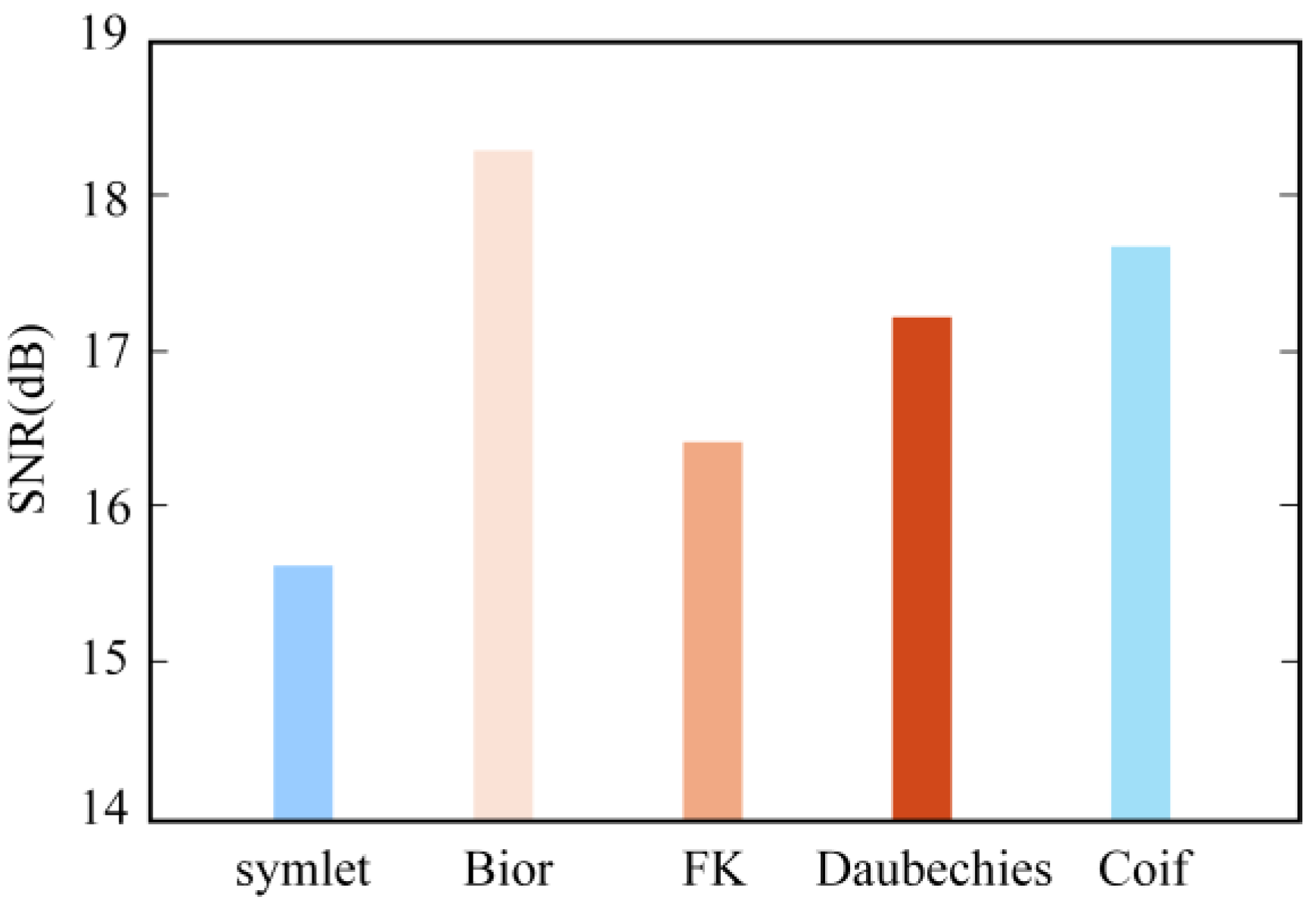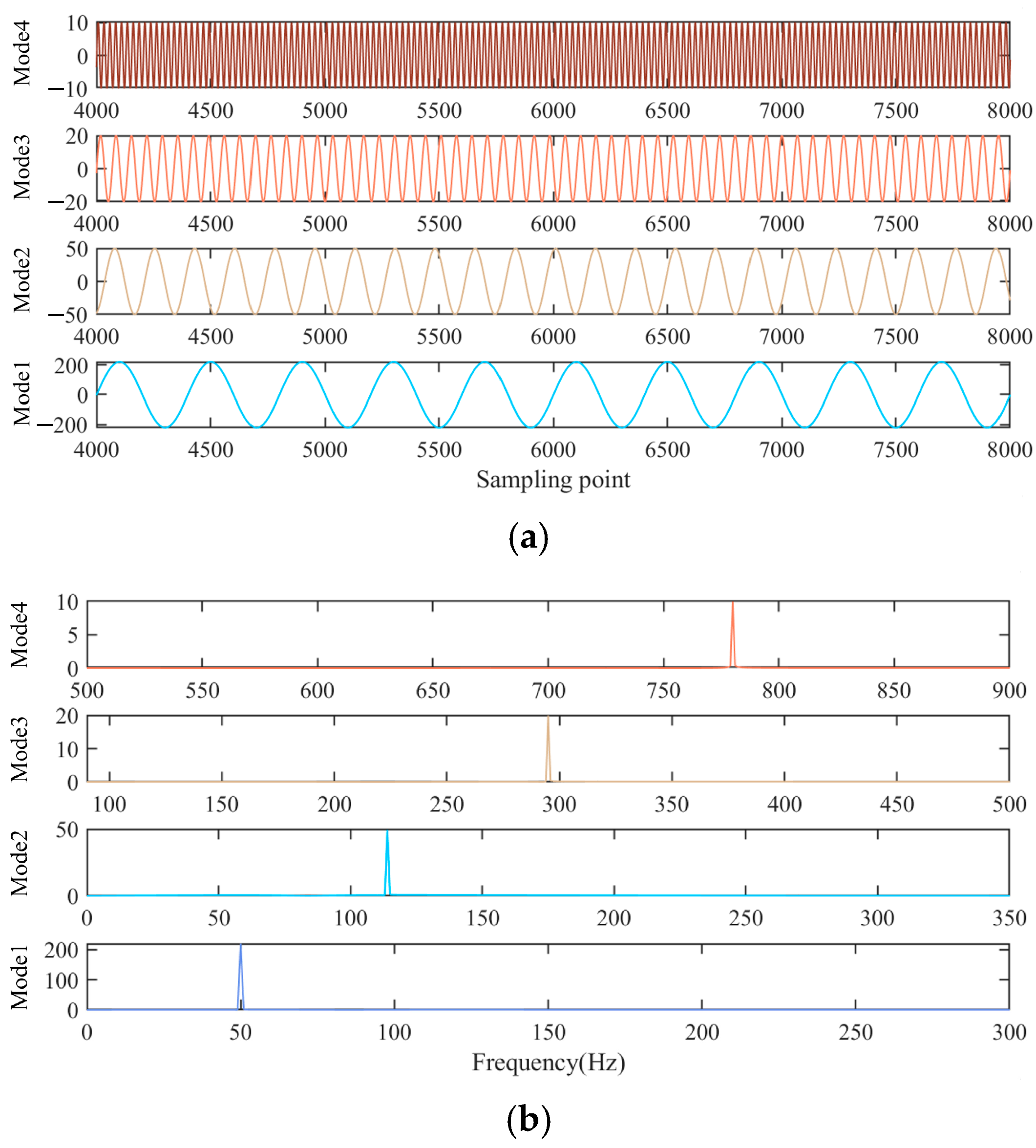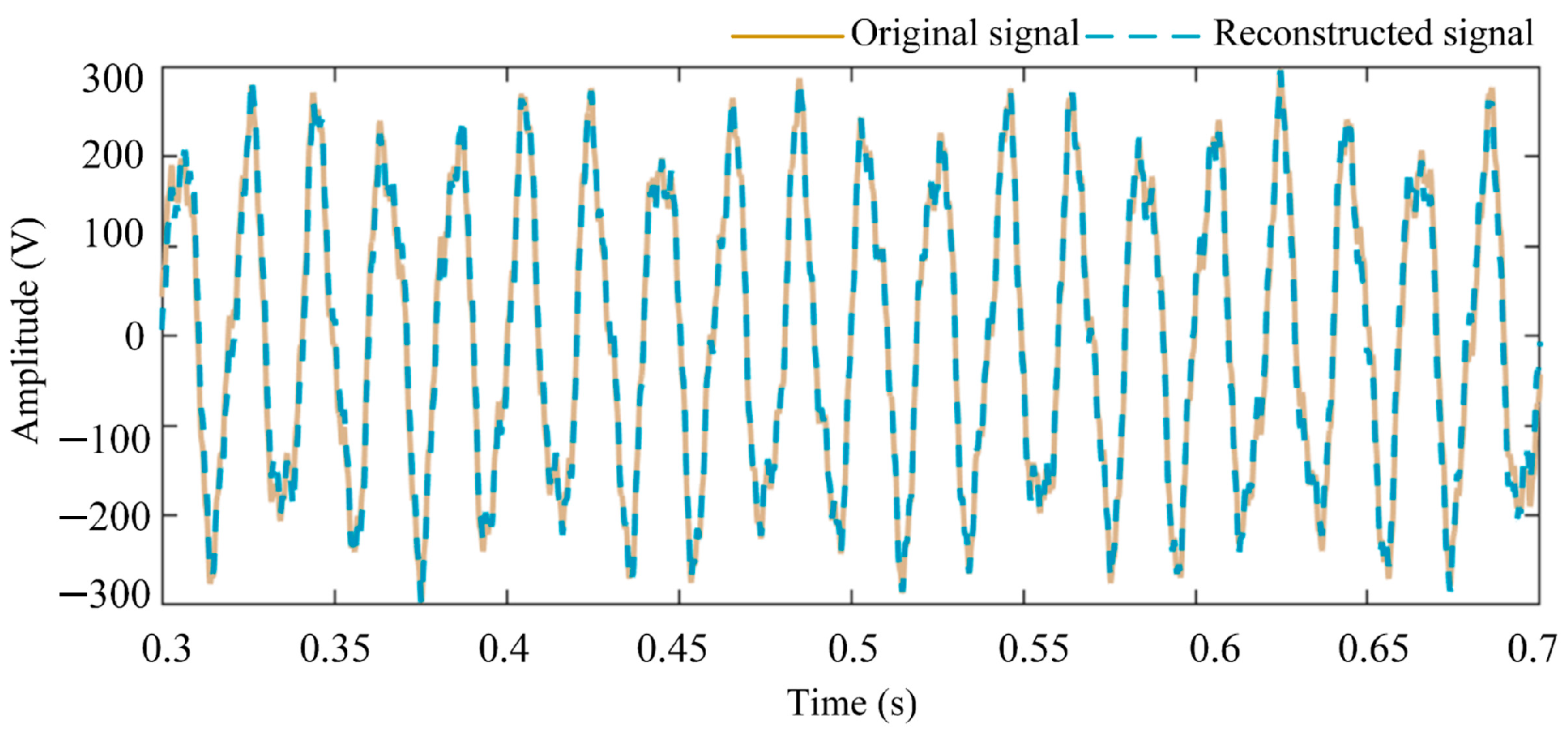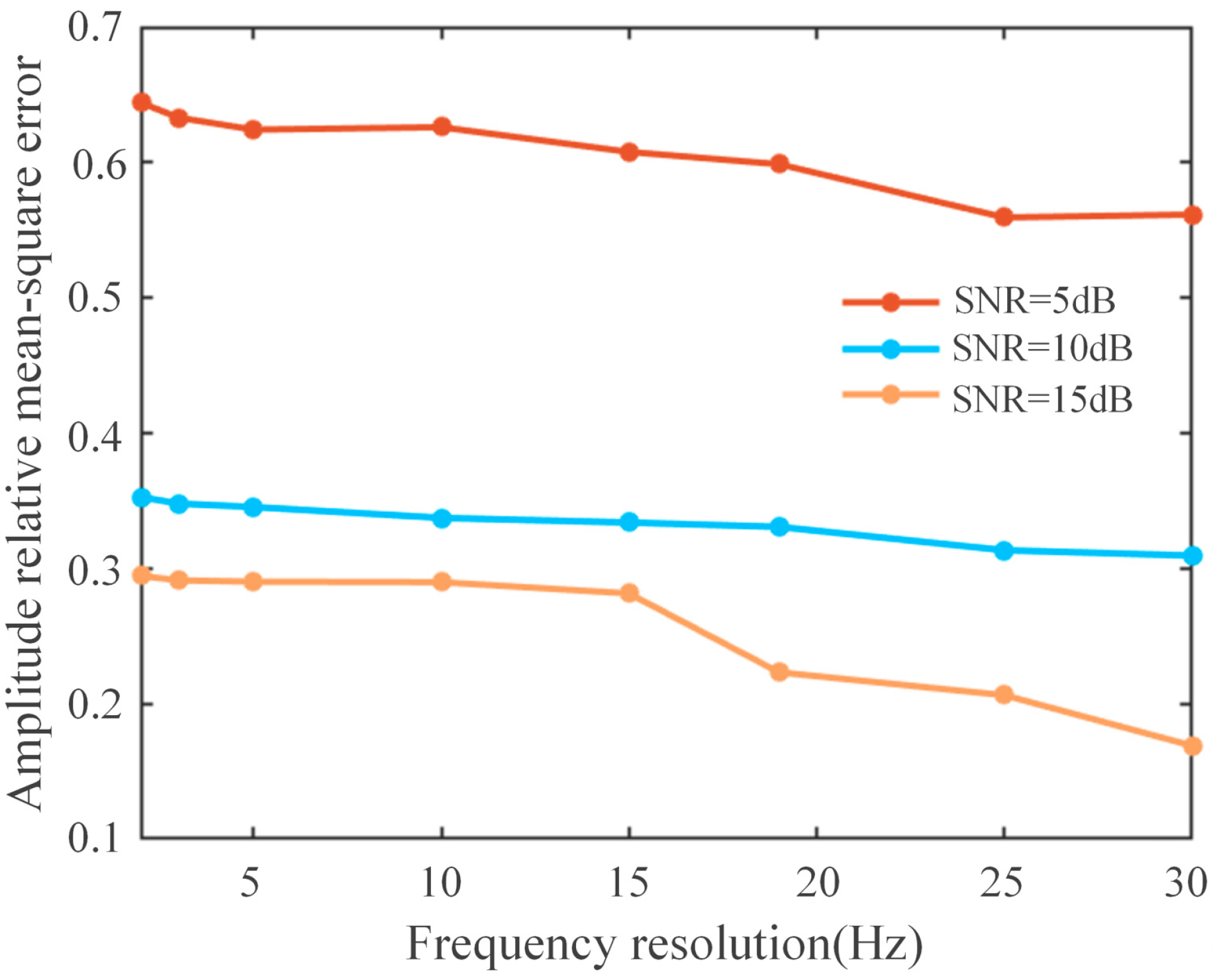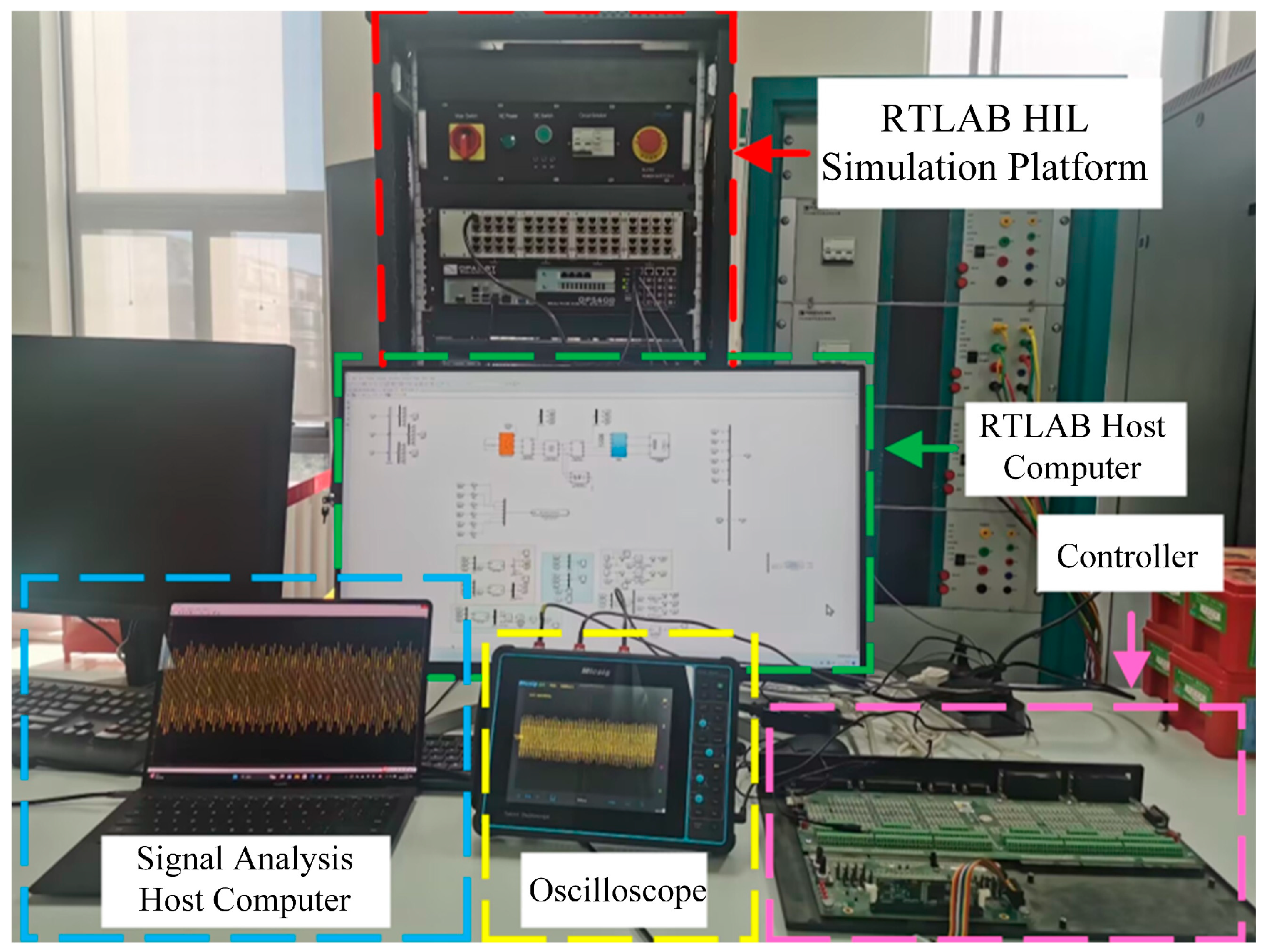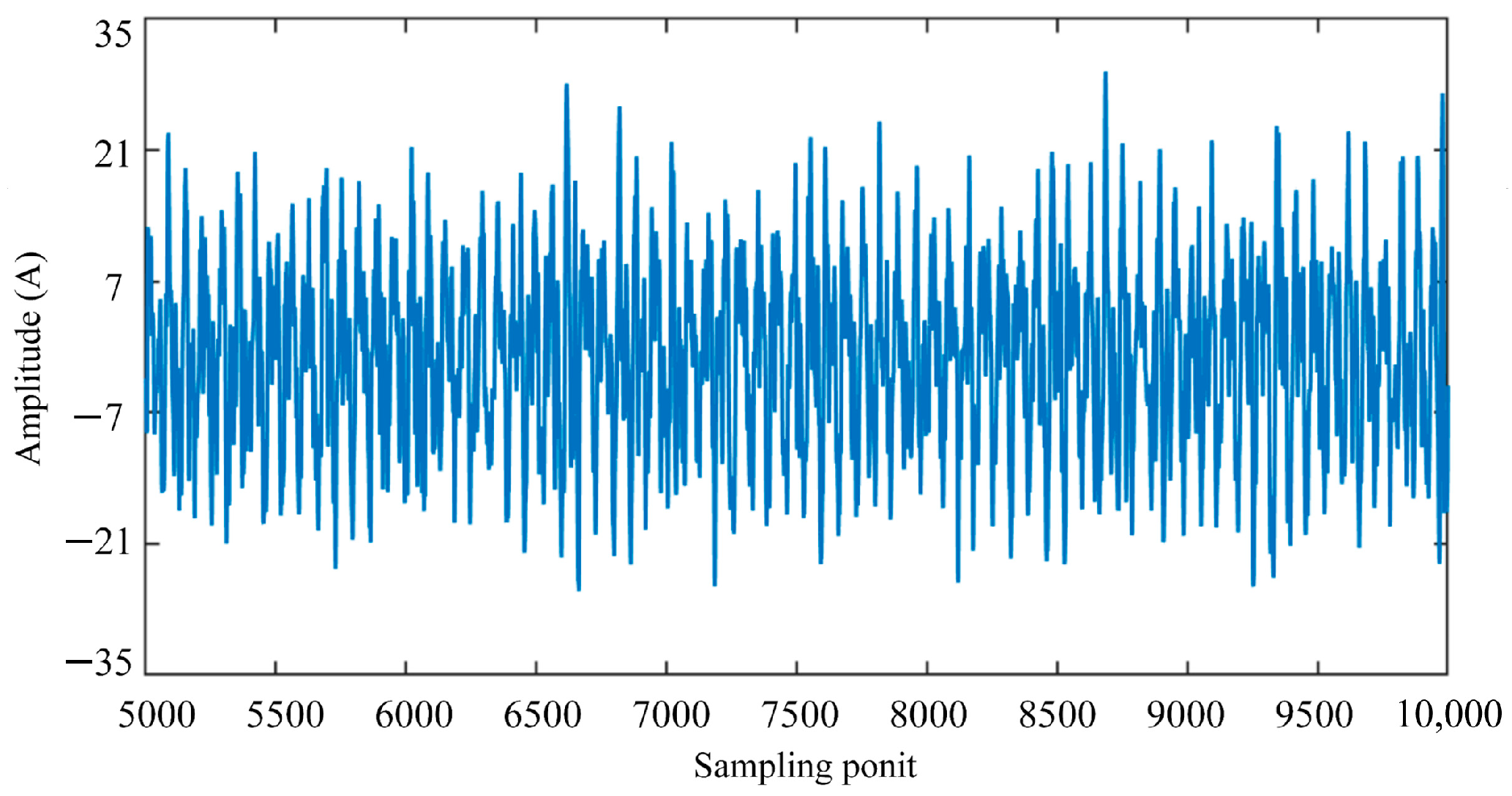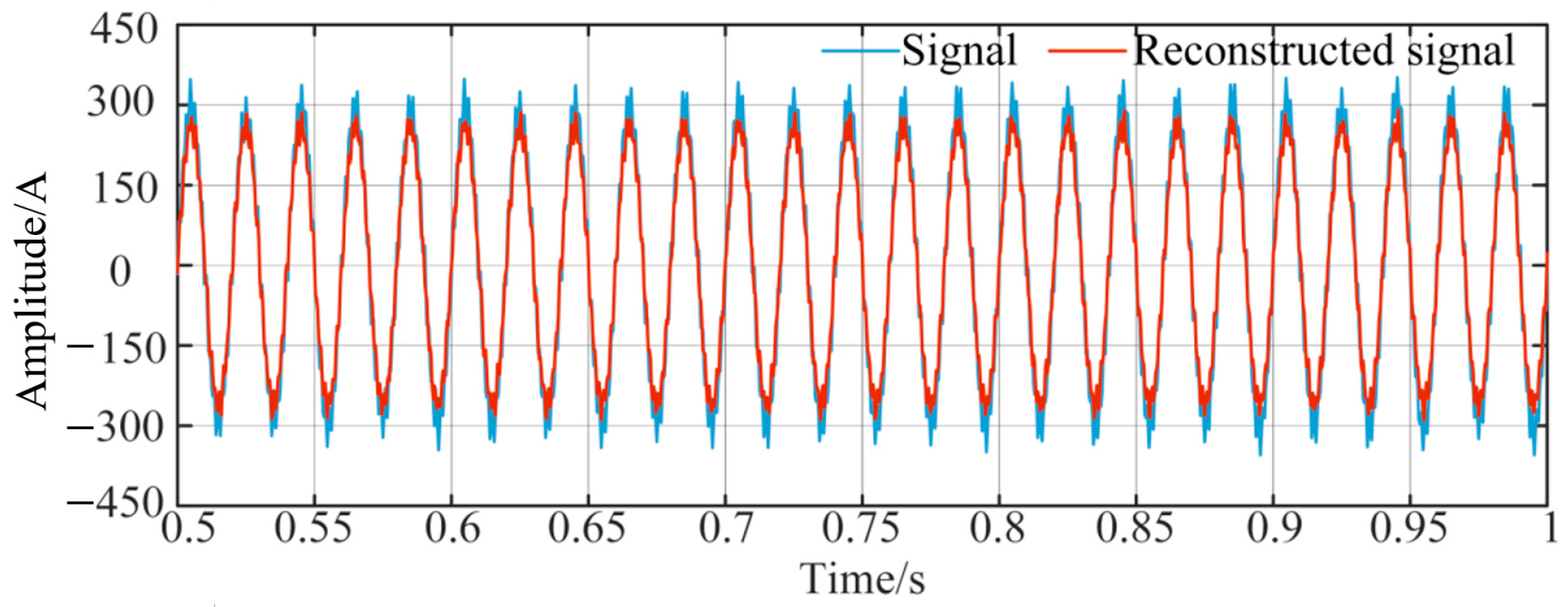1. Introduction
The integration of numerous power electronic devices due to high renewable energy penetration has altered power system dynamics, leading to frequent broadband oscillation events [
1,
2,
3]. Unlike traditional power system oscillations, these span from a few Hertz to kilohertz with significant noise interference, which seriously threatens the safe and stable operation of the power system [
4,
5].
Broadband oscillation events have occurred frequently and have had a wide range of impacts. In 2015, sub-synchronous and super-synchronous oscillations occurred at a wind farm in Xinjiang China, with the presence of 27–33 Hz and its complementary frequency 67–73 Hz component in the current, resulting in the shutdown of a thermal power unit 300 km away [
6,
7]. In 2017, three sub-synchronous oscillations with frequencies between 20 and 30 Hz occurred in Texas, USA, causing wind turbine trips and series capacitor bypasses [
8]. In 2019, a sub-synchronous oscillation at a wind farm in the London area of the United Kingdom caused 300 turbines to go off grid and left 1.1 million residents without power [
9]. The above broadband oscillation events severely impact the safe and stable operation of the power system; thus, research into the accurate measurement of broadband signals is imperative. However, in the actual measurement process, the signals are often compromised by various noises, introducing significant errors to the measurement results. Therefore, how to effectively reduce noise and accurately measure the broadband oscillation signal has become an urgent problem to be solved.
Common noise reduction methods for broadband signals in power systems include adaptive filters, compressed sensing, and wavelet transform. Adaptive filters adjust parameters based on signal autocorrelation, suitable for unknown signal and noise characteristics, but they are computationally complex and sensitive to initial parameter settings [
10]. Compressed sensing recovers sparse signals from limited measurements, ideal for high-dimensional data, but requires prior knowledge of signal sparsity and involves high computational complexity [
11,
12]. Wavelet transform (WT) offers multi-scale analysis, effectively capturing local signal features, analyzing different frequency ranges, and removing noise with low computational complexity and ease of implementation [
13,
14], the empirical wavelet transform (EWT) is an important improvement method to the wavelet transform, which is able to adaptively construct a wavelet filter bank according to the spectral characteristics of the signal, and shows better noise separation ability in non-smooth signal processing, but the computational complexity is high [
15].
Common broadband measurement algorithms in power systems can be divided into three categories: Fast Fourier Transform (FFT), modern spectral estimation methods and mode decomposition algorithms. FFT, a simple frequency-domain method, is widely used but limited by resolution tied to window length, spectral leakage, and fence effects [
16,
17,
18]. Modern spectral methods, including Prony, ESPRIT, and MUSIC, offer high-resolution measurement of harmonics and inter-harmonics, directly calculating amplitude, phase, and frequency. However, Prony is noise sensitive at low SNR [
19,
20], ESPRIT struggles in high-noise environments [
21], and MUSIC, despite a high-frequency resolution, has reduced performance and a high computational load at low SNRs [
22]. Mode decomposition methods, such as EMD, LMD, ICEEMDAN, FMD and REMD, decompose signals into smoother sub-signals to reduce interference. EMD and LMD are noise sensitive and prone to mode aliasing and endpoint effects [
23,
24,
25], while ICEEMDAN significantly reduces modal aliasing through adaptive noise addition and multiple ensemble averaging, but increases computational complexity [
26]. FMD utilizes an adaptive FIR filter to achieve accurate signal decomposition, but its application is limited primarily to mechanical fault signals [
27,
28]. RLMD mitigates endpoint effects through mirror extension algorithms, enhancing decomposition accuracy, but remains sensitive to noise [
29]. Compared to other methods, VMD reduces modal aliasing and endpoint effects through optimized parameter selection, improving decomposition accuracy [
30]. Furthermore, VMD can be optimized by adjusting its parameters, allowing for mode decomposition tailored to the characteristics of various signals [
31]. However, VMD alone cannot fully characterize each of IMF’s parameters, leaving limitations in parameter identification [
32].
In recent years, researchers have proposed some improved broadband measurement algorithms that are optimized based on traditional methods. The literature [
33] introduced a fast Taylor–Fourier transform (FTFT) algorithm, using Taylor series for dynamic signal tracking in broadband monitoring. The literature [
34] developed an adaptive accelerated MUSIC algorithm, improving frequency scanning speed and robustness under noise for transient power system conditions. The literature [
35] uses Wavelet Packet Transform (WPT) preprocessing to suppress the noise, combined with ICEEMDAN to extract the effective IMF components, and finally resolves the signal parameters by Hilbert Transform (HT). The literature [
36] proposed an EMD-assisted Prony algorithm, which integrates EMD’s signal decomposition capability with Hurst index-based noise identification to effectively eliminate noise. The denoised signals are then processed using Prony for parameter identification, enabling high-precision measurement and analysis of power system signals.
The general idea of this paper has similarities with the literature [
36]; both adopt the idea of combining mode decomposition and Prony algorithm, but there are significant differences in the technical implementation. This study innovatively adopts a three-stage cascade processing architecture: firstly, an improved smoothed linear segmented threshold wavelet denoising method is proposed, and through the dynamic threshold adjustment mechanism and transition region smoothing processing, the high-frequency weak component of the signal is retained in its entirety while effectively suppressing the noise, and the high-quality input signal is provided for the subsequent measurement of broadband signals. A dual optimization based on information entropy and energy entropy is then introduced on the basis of the traditional VMD to realize the modal number and penalty factor optimization. Then, a dual optimization strategy based on information entropy and energy entropy is introduced on the basis of the traditional VMD to realize the adaptive matching of modal number and penalty factor, which ensures that the decomposed modal components have clear physical meanings and good separation characteristics in the frequency domain, so as to avoid the common modal aliasing problem. Finally, the Prony algorithm is applied to the optimized modal components. Since each modal component has been pre-processed and optimized for the decomposition and has a relatively simple frequency component, the Prony only needs to process the low-order model to realize high-precision parameter identification.
In summary, this paper proposes a broadband measurement algorithm based on smooth linear segmented threshold wavelet noise reduction and improved VMD-Prony, aiming at solving the problems of noise interference and insufficient measurement accuracy during the measurement of broadband signals. The main contributions of this paper are as follows:
- (1)
A smooth linear segmented threshold (SLST) wavelet denoising method is proposed. By setting upper and lower thresholds and smoothing the coefficients within the threshold range, the method effectively reduces noise interference while retaining the effective information of the signal and improving signal quality.
- (2)
The VMD algorithm is improved to optimize the number of modes and the penalty factor. By selecting the number of modes with the largest mutual information entropy, the over-decomposition and under-decomposition phenomena are avoided, and the accuracy of the decomposition results is guaranteed; by minimizing the energy entropy and selecting the optimal penalty factor, the energy distribution of each mode in the frequency domain is concentrated as much as possible, which improves the accuracy of the signal decomposition, and avoids the phenomenon of modal overlapping effectively.
- (3)
The Prony is applied to each modal function after VMD decomposition, which realizes the accurate identification of parameter information, such as frequency, amplitude and phase of each mode, thus realizing the accurate measurement of broadband signals.
The rest of the paper is organized as follows.
Section 2 describes the overall design framework of the broadband measurement algorithm.
Section 3 details the principle and improvement part of the algorithm.
Section 4 performs the validation using the proposed algorithm.
Section 5 discusses the proposed algorithm.
Section 6 summarizes the paper.
2. Overall Design of Broadband Measurement Algorithms
To address the issues of noise interference and the lack of accuracy in signal recognition during the measurement of broadband signals, this paper proposes a novel broadband measurement algorithm that integrates smooth linear segmented threshold wavelet denoising with an improved VMD-Prony. The overall design block diagram of the proposed algorithm is depicted in
Figure 1.
The main steps include:
Step 1: Signal Denoising. The broadband signal is subjected to multi-scale wavelet decomposition to yield a set of wavelet coefficients. An appropriate threshold is selected for these coefficients, followed by wavelet inverse transformation of the threshold coefficients to complete the denoising process. Additionally, the effectiveness of the noise reduction is evaluated by Pearson’s correlation coefficient and SNR.
Step 2: Mode Decomposition. To address the presence of multiple signal components at varying frequencies within the broadband signal, the VMD algorithm is employed to decompose the signal into several distinct modes, each characterized by a finite bandwidth and a central frequency. The number of modes k and the penalty factor α are optimized based on mutual information entropy and energy entropy criteria, ensuring that the reconstructed signal from the sum of modes closely matches the original broadband signal, while minimizing the total bandwidth across all modes.
Step 3: Parameter Identification. For each decomposed mode, the Prony is employed to identify the parameters. The model order p is selected based on the characteristics of the individual modes. Prony equations are constructed using the data points of each mode. The parameters, including frequency, amplitude, and phase of the signals, are determined by solving the resulting system of equations. Subsequently, the signals are reconstructed using the identified parameter information.
4. Simulation Verification
4.1. Broadband Signal Noise Reduction Preprocessing
To verify the effectiveness of the method designed in this paper for the measurement of broadband signals in power systems, it is first necessary to carry out noise reduction on the test signal containing noise to avoid the interference of noise on the subsequent signal measurement process.
To establish the test signal shown in (33), the test signal consists of the original signal and noise. Considering the wide frequency distribution of broadband oscillation and the possibility of containing multiple oscillation components, the original signal contains four broadband oscillation frequencies, 33 Hz, 87 Hz, 246 Hz and 1500 Hz, in addition to the fundamental frequency 50 Hz, and the oscillation amplitude is generated randomly. The noise contains Gaussian white noise and background noise, where
NG(
t) adds Gaussian white noise with a signal-to-noise ratio of 10 dB, and
NP(
t) adds random impulse noise with an amplitude four times that of the background noise, and the random impulse noise is set to have a coverage of 5% in the time domain. The sampling frequency is set to 10 kHz and the time length of monitoring data is set to 1 s. The test signal model used is as follows:
In (34), x1(t) is the original signal, xN is the noise, and NG and NP are Gaussian white noise and impulse noise, respectively.
The waveforms of the original signal without noise and the test signal containing noise are shown in
Figure 3a,b, respectively. From the figures, it can be visualized that the test signal has random fluctuations superimposed on the original signal, indicating that the noise interferes seriously with the test signal.
Using the SLST wavelet denoising method proposed in this paper, the test signal is denoised. According to the noise characteristics of the test signal (Gaussian white noise with an SNR of 10 dB and impulse noise with 5% coverage), the Bayes threshold method is used to calculate the lower threshold, λ
1 = 0.4. The upper threshold λ
2 is set to 0.6 to ensure the effective retention of signal features (such as low-amplitude components at 1500 Hz) in the smooth transition region while suppressing noise interference. The noise-reduced test signal is compared with the original signal without noise, and the original signal and the denoised signal are compared as shown in
Figure 4.
As can be seen from
Figure 4, the denoised signal and the original signal not only fit well on the overall waveform, but also fit relatively well on the local waveform, indicating that the wavelet noise reduction method proposed in this paper can effectively eliminate the noise and retain the effective information of the original signal.
To evaluate more specifically the noise reduction effect of the designed method on test signals containing noise, the Pearson Correlation Coefficient and the SNR are used as the evaluation indexes.
.
In (35) and (36), S is the original signal without random noise interference, Sn is the signal after adding noise interference, Sde is the signal after noise reduction, Sn,m and Sde,m are the mean value of the signal with noise interference and the noise reduction signal, and n is the length of the signal. The value of the Pearson correlation coefficients ranges from −1 to 1. A Pearson correlation coefficient close to 1 indicates a high degree of correlation between the noise-reduced signal and the original signal, suggesting a superior noise reduction effect. Conversely, a value close to −1 implies a strong negative correlation, while a value of 0 indicates no linear correlation. Additionally, a higher SNR corresponds to lower noise content and a better noise reduction outcome.
To verify the advantage of SLST wavelet denoising proposed in this paper over other types of noise removal methods in terms of noise removal effect, the test signals are analyzed and compared with linear filtering, compression-aware and Empirical Wavelet Transform (EWT) methods. As shown in
Figure 5, the SLST wavelet denoising method proposed in this paper has the best noise reduction effect.
To verify the reasonableness of choosing the Bior wavelet basis function for SLST wavelet noise reduction, we applied five different wavelet basis functions, namely, symlet, Bior, Fejér-Korovkin (FK), Daubechies and Coiflet (Coif), to the test signals for noise reduction. By comparing and analyzing the noise reduction effect of each wavelet basis function, it can be intuitively found in
Figure 6 that the Bior wavelet basis function shows certain advantages in noise reduction performance compared with other types of wavelet basis functions.
To further verify the noise reduction effect of the method proposed in this paper, the test signals are analyzed and compared with the three wavelet noise reduction methods using HT, ST and the SLST proposed in this paper, respectively.
The SNR and Pearson’s coefficient of the test signal before noise reduction are 8.38 and 0.9291, respectively, and the results of the SNR and Pearson’s coefficient of the test signal after noise reduction with the three wavelet noise reduction methods, respectively, are shown in
Figure 7.
From
Figure 7, we can see that using the wavelet denoising method with SLST wavelet denoising method proposed in this paper, the Pearson’s coefficient takes a value closer to 1 and the SNR takes a larger value relative to the HT and ST, which indicates that after using the noise reduction method in this paper, the noise reduction signal has a higher correlation with the original signal, and the noise reduction effect is better.
The results of the quantitative comparison of different thresholding methods are given in
Table 1. From
Table 1, we can see that after using three different threshold wavelet noise reduction methods, the SNR of denoised signals is improved by 8.4, 9.02, and 9.92, respectively. The SNR of denoised signals is improved by 0.061, 0.0629, and 0.0645, respectively. The SLST wavelet denoising method proposed in this paper has the best performance in the evaluation indexes of the noise reduction effect, which is more suitable for the application in high-noise broadband signals.
4.2. Broadband Signal Simulation Test
The test signal consists of a fundamental frequency signal and an oscillating signal within the 2.5–1000 Hz range. In the previous section, we verified that after preprocessing of noise reduction of the broadband signal, the interference noise is removed with good effect, and the effective information of the signal is retained intact, so for the simplification of the simulation test, the existence of noise interference of the signal is not considered.
To verify the decomposition effect of the VMD and the accuracy of Prony parameter identification, the test signal of (37) is constructed. Considering the wide range of broadband oscillation frequency distribution and the possibility of multiple oscillation components, four broadband oscillation frequencies are generated in addition to the fundamental frequency of 50 Hz, and the amplitude of oscillation is generated randomly. The signal expression is as follows:
The mode decomposition of the above signal is carried out by using the parameter-optimized VMD. The modal number
k is determined to be four by mutual information entropy optimization, matching on the four main frequency components of the test signal. The penalty factor
α is determined by energy entropy minimization to be 2100. The VMD decomposition results are shown in
Figure 8:
Figure 8a shows the time-domain decomposition results of each mode, and
Figure 8b shows the frequency-domain decomposition results of each mode. We can intuitively see that the method proposed in this paper can effectively separate the modes.
After mode decomposition of the signal by VMD, a complex signal can be decomposed into a series of modes, each of which represents a component of the signal in a different frequency band.
As shown in
Figure 8b, each mode of the VMD decomposition contains a single center frequency and the number of significant frequency peaks
Npeaks is 1. Therefore, for each mode, the model order
p is set to 2. Prony recognizes the information of each mode parameter and linearly combines all modes to obtain the reconstructed signal. As shown in
Figure 9, the original signal fits well with the reconstructed signal, indicating that the parameter identification of the signal is relatively accurate.
After the mode decomposition of the signal by VMD, the amplitude, phase, frequency information and relative error percentage of each mode are identified by Prony as shown in
Table 2.
As can be seen from
Table 2, the relative error between the frequency discrimination value and the theoretical value of each mode is 0, which proves that the frequency discrimination is excellent, and the relative error percentages between the amplitude discrimination value and the theoretical value of mode 1, mode 2, mode 3 and mode 4 are 0.271%, 1.2210%, 0.5665%, 0.1.883%, respectively, and the deviation of the discrimination value and the theoretical value can be approximately neglected. This shows that the parameter identification of the signal is relatively accurate.
To demonstrate the effectiveness of the proposed method in noise reduction and accurate measurement, several typical broadband measurement algorithms, including EMD, FFT, ESPRIT, MUSIC and Prony, were selected for comparative analysis. Specifically, EMD was configured to extract four IMFs: FFT utilized a 1024-point Hamming window, and ESPRIT, MUSIC, and Prony all employed a model order of ten. These parameter settings were optimized through preliminary experiments to ensure a fair and comprehensive evaluation of performance. To investigate the signal reconstruction results of different methods at different noise levels and different frequency intervals, the test simulation results of amplitude are shown in
Figure 10.
As can be seen in
Figure 10, the FFT consistently exhibits high RMSE values, approximately 3.0, due to its sensitivity to noise, spectral leakage, and limited frequency resolution. EMD reduces processing complexity by decomposing signals into IMFs. When the SNR increases from 5 dB to 30 dB, its RMSE shows a modest decline from 1.2 to 1.0, indicating that a higher SNR mitigates noise interference in mode decomposition. However, inherent issues like mode mixing and end effects prevent EMD from accurately separating closely spaced frequency components, resulting in high RMSE values. The ESPRIT algorithm demonstrates a moderate improvement, with RMSE decreasing from 1.5 to 1.3 as SNR rises and the frequency spacing widens. Yet, under high noise or narrow frequency intervals, its subspace decomposition becomes vulnerable to noise, limiting resolution and maintaining higher errors. Although Prony’s method is noise sensitive, with its linear prediction coefficients prone to distortion, it achieves greater robustness for test signals with distinct frequency components through direct fitting, stabilizing RMSE at approximately 1.0 and outperforming ESPRIT in this scenario. MUSIC exhibits an extremely high-frequency resolution. However, under low SNR conditions, noise significantly interferes with subspace decomposition. As the SNR increases from 5 dB to 30 dB, the RMSE of MUSIC decreases markedly. The proposed algorithm in this study demonstrates remarkable superiority, maintaining RMSE consistently below 0.6. As illustrated in
Figure 11, its RMSE decreases significantly with increasing SNR and frequency spacing, with a minimum RMSE of 0.17. These results conclusively validate the algorithm’s exceptional noise suppression capability and high-frequency resolution performance.
4.3. Hardware-in-the-Loop Simulation Testing
To verify the applicability of the broadband oscillation measurement algorithm proposed in this paper in the real power system, the simulation arithmetic of the PV grid-connected system is constructed, as shown in
Figure 12. The circuit parameters for the PV grid-connected model are detailed in
Table 3.
As shown in
Figure 13, a RTLAB Hardware-in-the-Loop (HIL) simulation platform was constructed. The platform consists of RTLAB, an RTLAB host computer, a controller, an oscilloscope and a signal analysis host computer. RTLAB can compile and simulate the PV grid-connected model in Simulink and perform an HIL simulation by interacting with external hardware circuits through the IO boards and FPGAs carried in the machine. In the experiment, by adjusting the parameters of the PV grid-connected inverter controller and line impedance parameters to make its AC side generate the expected broadband oscillating signals to simulate the dynamic behavior of the signal source, and then synchronously collect and process the voltage and current signals, and input the collected data into the proposed broadband measurement algorithm model for measurement.
The platform consists of RTLAB, an RTLAB host computer, a controller, an oscilloscope and a signal analysis host computer. RTLAB can compile and simulate the PV grid-connected model in Simulink, and perform an HIL simulation by interacting with external hardware circuits through the IO boards and FPGAs carried in the machine. In the experiment, by adjusting the parameters of the PV grid-connected inverter controller and line impedance parameters to make its AC side generate the expected broadband oscillating signals to simulate the dynamic behavior of the signal source, and then synchronously collect and process the voltage and current signals, and input the collected data into the proposed broadband measurement algorithm model for measurement.
Phase A current
ia is selected as the signal to be analyzed, and the current signal on the oscilloscope is captured, and its oscillating waveform is shown in
Figure 14.
Because of the need to verify that the broadband measurement algorithm in this paper can reduce noise interference, the simulation example artificially adds a noise source. According to the oscillating signal data shown in
Figure 14, the noise reduction preprocessing is carried out on the broadband signal by using the SLST wavelet denoising method, and the noise-reduced signal is decomposed by the parameter-optimized VMD, which decomposes multiple modes, as shown in
Figure 15.
From
Figure 15, we can see that the five main modes are decomposed, containing one fundamental frequency mode and four main oscillatory modes of the system. The Prony is used to identify the parameters of each mode after the VMD decomposition, and the frequency, amplitude, and phase parameter information of the center of each mode is obtained as shown in
Table 4.
Since the real parameter information of the A-phase current signal is unknown, the current signal reconstruction is realized by linear combination of the modal parameter information obtained by identification, and the effectiveness of the algorithm proposed in this paper on the accurate measurement of the signal is verified by comparing the fitting degree of the collected original current signal and the reconstructed signal. To compare the original current signal with the reconstructed signal more intuitively and clearly, the comparison graph is locally enlarged, as shown in
Figure 16.
From
Figure 16, we can see that the reconstructed signal is basically consistent with the original signal waveform and the fitting degree is high, which verifies that the proposed algorithm can make an accurate measurement of the signal and effectively obtain the relevant parameter information of the oscillating signal.
4.4. Actual Recorded Wave Data Testing
The effectiveness of the proposed method is verified based on the fault recording data of a 35 kV photovoltaic power station under the jurisdiction of a substation in Ningxia, China. The waveform of the A-phase current recording data of the 35 kV busbar is shown in
Figure 17, and the current signal consists of a fundamental component, a sub-synchronous component with a frequency of 31 Hz, a component with a larger amplitude of 69 Hz, and some harmonic interferences with smaller amplitudes.
The coefficient of determination
R2 was chosen as an index for evaluating the measurement results, and was used to measure the difference between the reconstructed signal and the original signal, the closer R
2 is to 1, the better the reconstructed signal fits the original signal. The closer R
2 is to 1, the better the reconstructed signal fits the original signal, and the more accurate the proposed broadband oscillation signal measurement method is. The range of R
2 is from 0 to 1, and R
2 ≥ 0.9 is usually taken as the criterion of high precision fitting, and the specific formula is as follows.
where
n is the number of data points,
xi is the ith value of the original signal,
is the ith value of the reconstructed signal, and
is the mean value of the original signal.
Using the proposed method to measure the current signal, the reconstructed signal and the original signal comparison chart are shown in
Figure 18, which can be visualized that the reconstructed signal and the original signal waveform is basically consistent and high degree of fit. In addition, the calculated R
2 value of the reconstructed signal to the original voltage signal is 0.925, which exceeds the criterion for high-precision fitting, further indicating that the proposed method can realize the accurate measurement of the signal.
5. Discussion
The proposed algorithm combines SLST wavelet denoising, optimized VMD, and Prony-based parameter identification to address noise interference and measurement inaccuracies in broadband signal analysis. The SLST method introduces a smooth transition zone between thresholds, effectively preserving signal features while suppressing noise. In tests with mixed Gaussian and impulse noise, SLST improved the SNR by 118% (from 8.38 to 18.30) and Pearson’s correlation to 0.9936, outperforming hard/soft thresholding by 9–18% in denoising efficiency. The dual-entropy optimized VMD (k = 4, α = 2100) achieved precise decomposition of four frequency signals with negligible aliasing. Subsequent Prony analysis achieved perfect frequency detection and kept amplitude errors below 1.9%, reducing RMSE by over 50% compared to conventional methods. Through HIL simulations and field testing on a 35 kV PV system, the algorithm demonstrated excellent waveform fidelity, achieving a coefficient of determination R2 of 0.925 between the original and reconstructed signals, validating the algorithm’s effectiveness for power system broadband oscillation analysis.
However, the algorithm’s computational complexity, driven by VMD and Prony iterations, increases with signal frequency complexity or higher sampling rates, limiting real-time performance for long-term monitoring. Future work will explore advanced decomposition techniques, such as ICEEMDAN, to enhance noise robustness and decomposition accuracy for complex signals. Additionally, optimizing computational processes and leveraging hardware acceleration, such as GPUs or FPGAs, will be investigated to improve real-time processing in practical applications.
6. Conclusions
In this paper, a broadband measurement algorithm based on SLST wavelet denoising and improved VMD-Prony is proposed, and its effectiveness is verified by simulation tests. The main conclusions are as follows:
The SLST wavelet denoising method can effectively remove the noise interference, retain the effective information of the signal, and improve the signal quality. Compared with the hard threshold and soft threshold methods, the noise reduction method proposed in this paper performs better in terms of signal-to-noise ratio and Pearson’s correlation coefficient and can better adapt to the broadband signal noise reduction needs in the high-noise environment.
The improved VMD can decompose the broadband signal into multiple modes with center frequencies, which reduces the complexity of signal processing and improves the decomposition accuracy. Optimizing the VMD parameters by mutual information entropy and energy entropy can effectively avoid the phenomenon of modal aliasing and improve the accuracy of signal decomposition.
The algorithm proposed in this paper can accurately identify the parameters of each mode, obtain the frequency, amplitude, phase and other parameter information of each mode, and performs better in amplitude identification accuracy and frequency resolution compared with the traditional methods of EMD, FFT and ESPRIT.
The broadband measurement algorithm proposed in this paper has achieved good results in simulation tests and HIL simulation tests, and can be effectively applied to the analysis of broadband oscillations in power systems, providing important technical support for the safe and stable operation of power systems.
